Examining the Gospel of Matthew-1
Mike Ervin
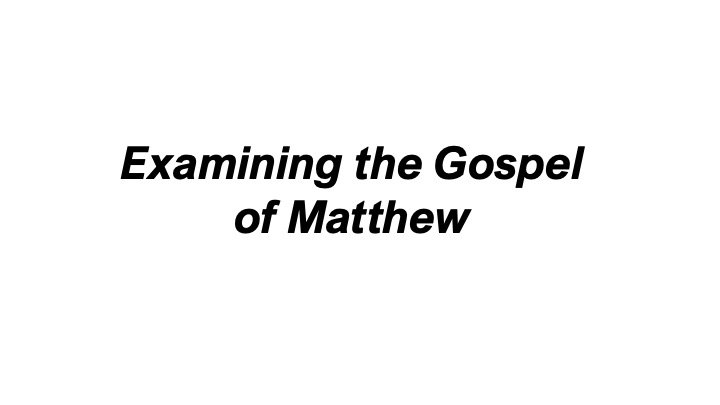
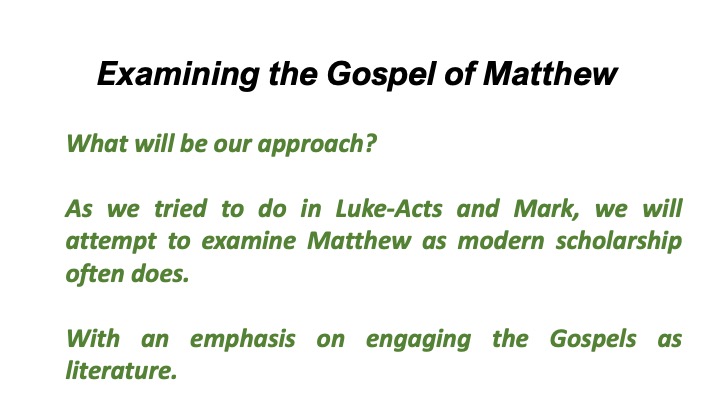
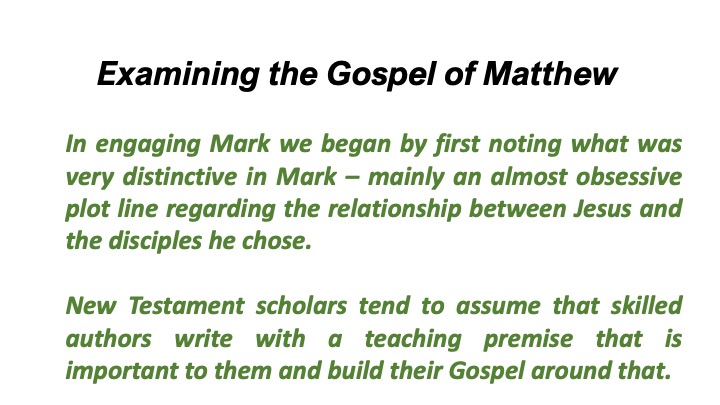
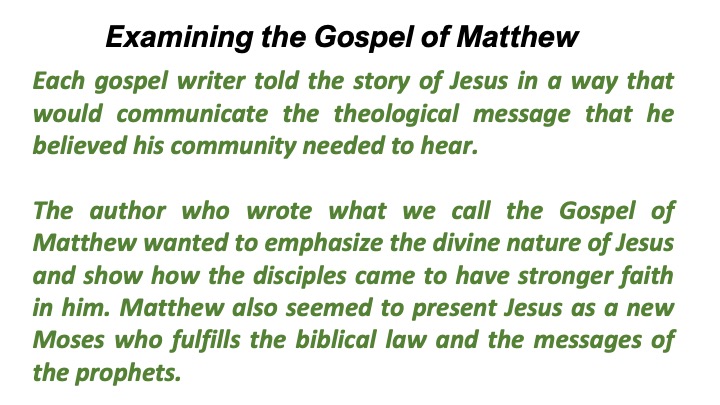
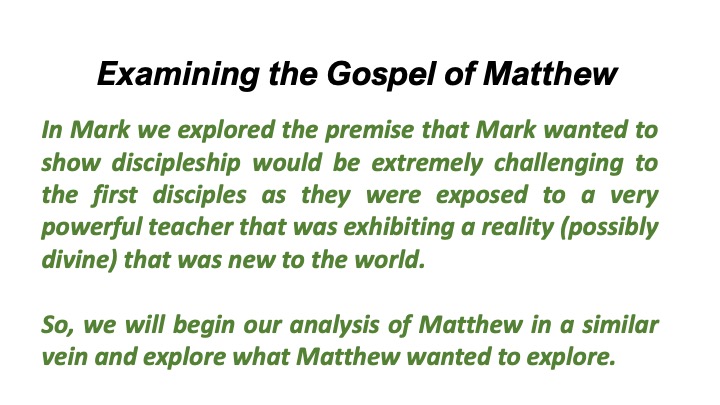
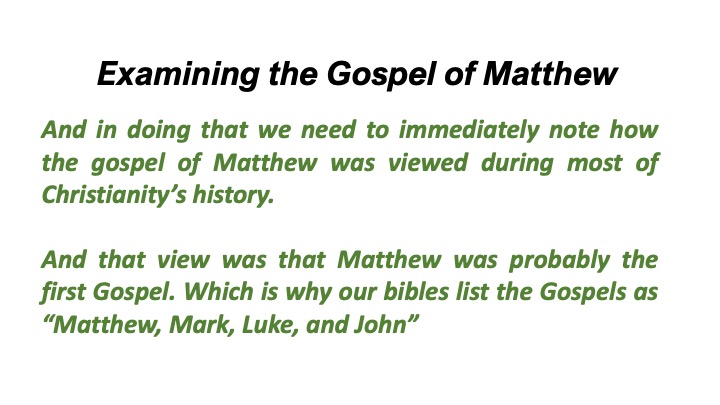
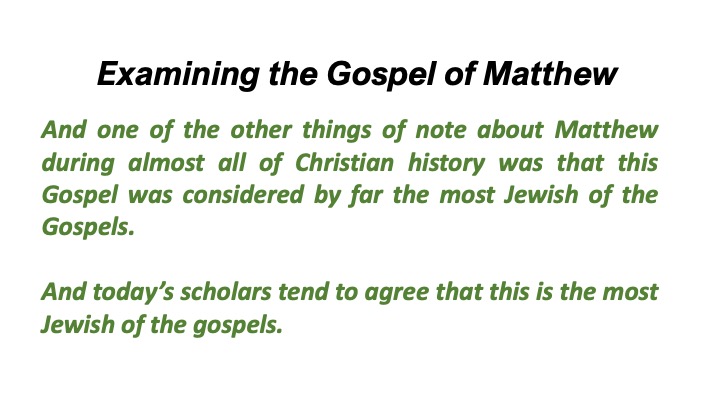
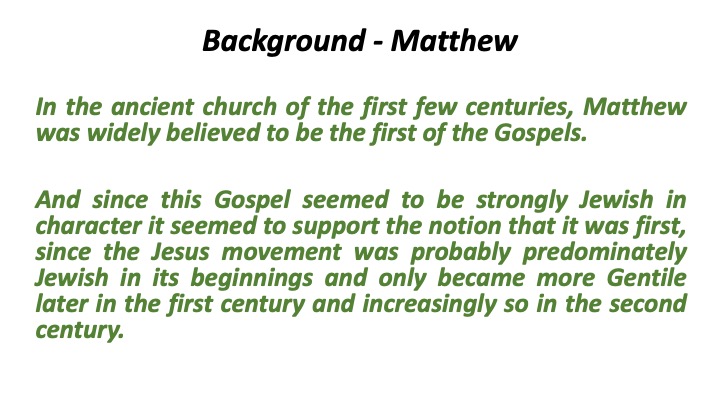
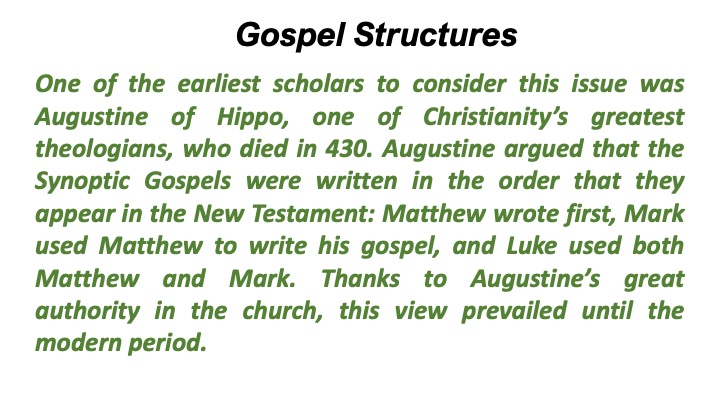
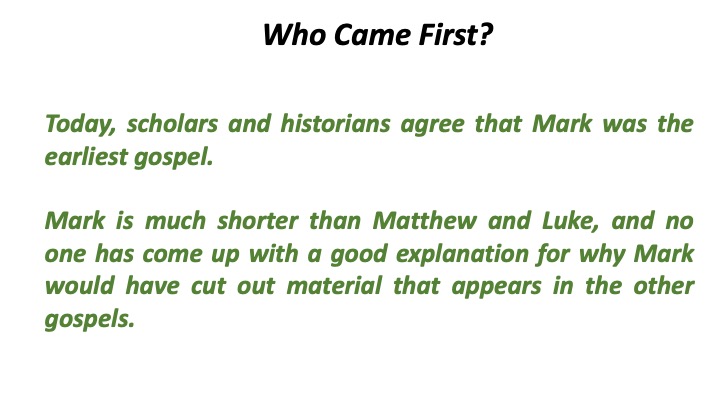
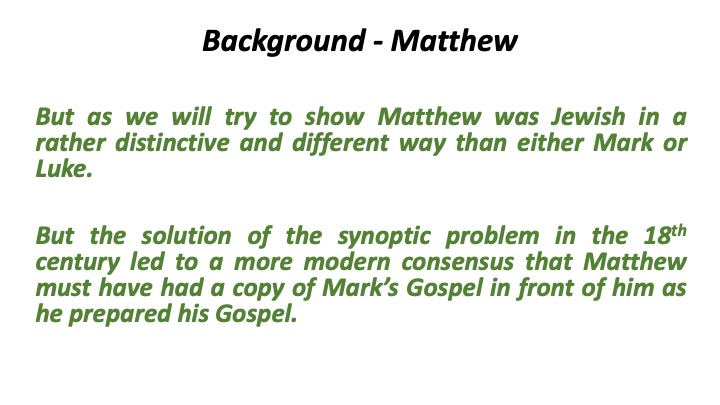
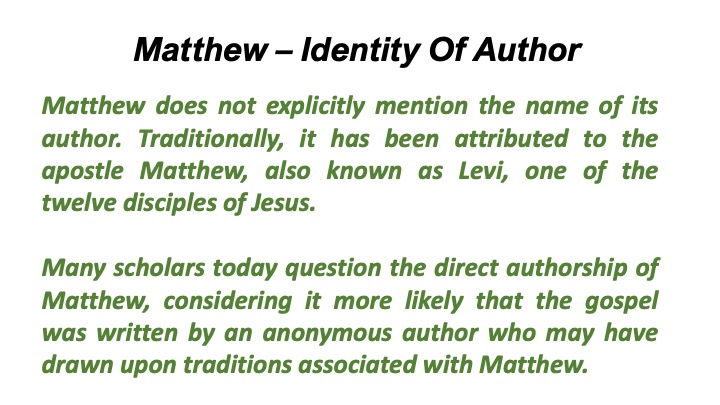
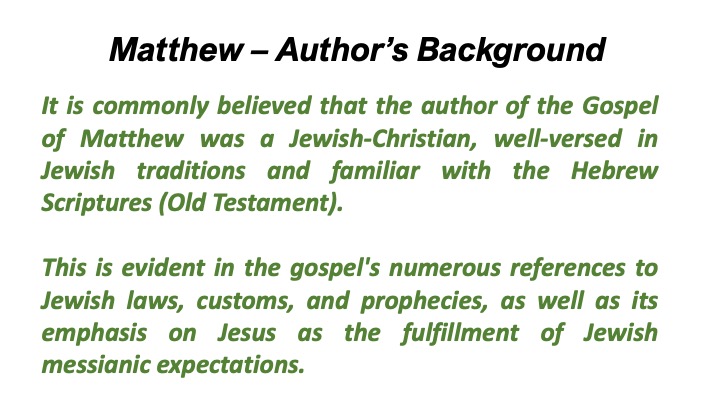
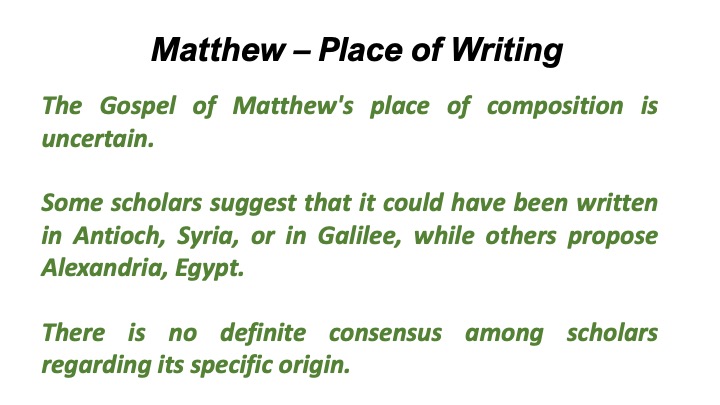
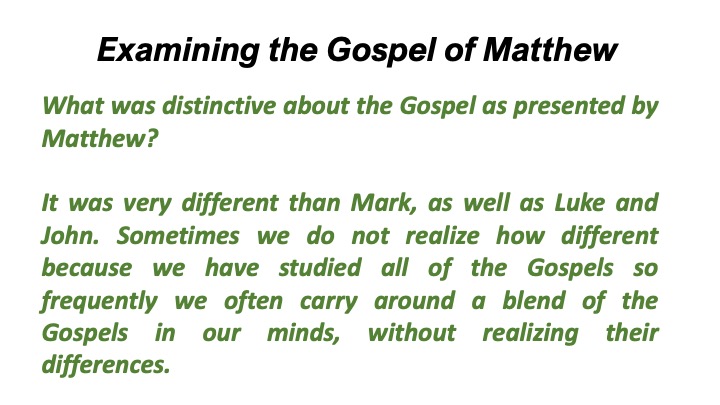
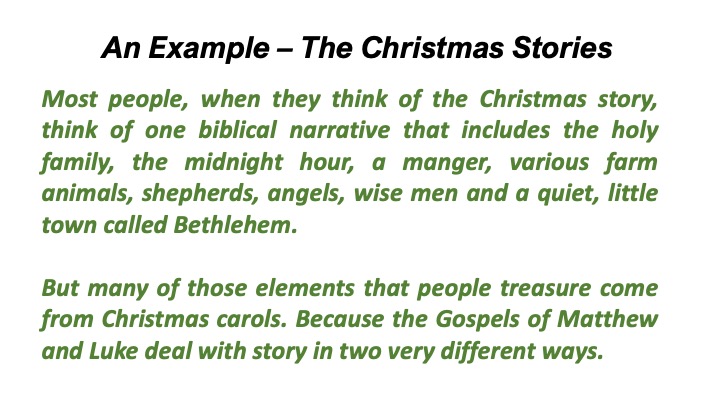
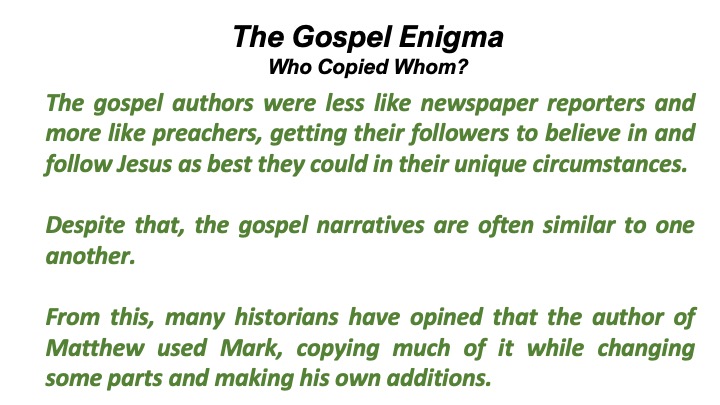
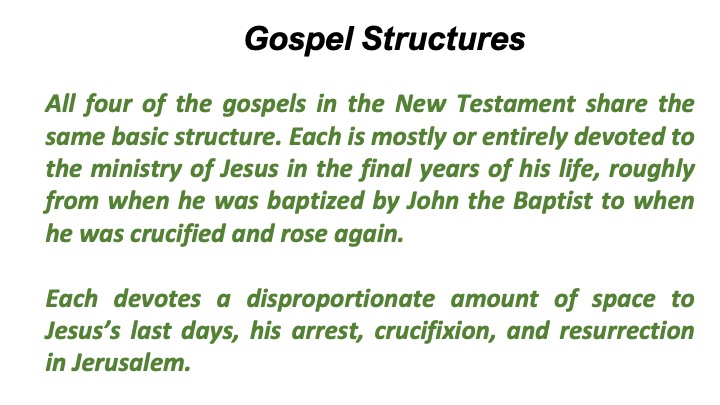
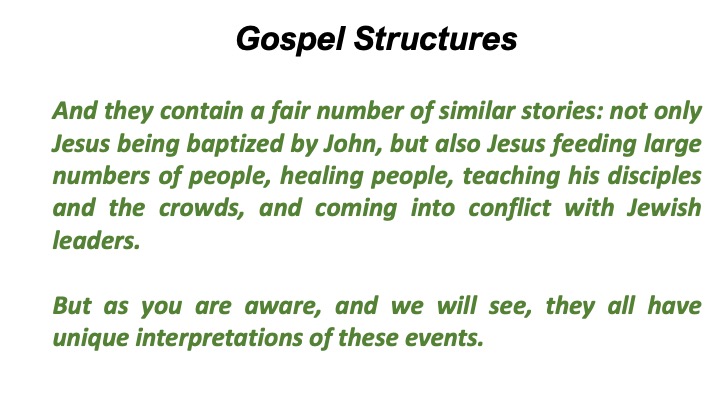
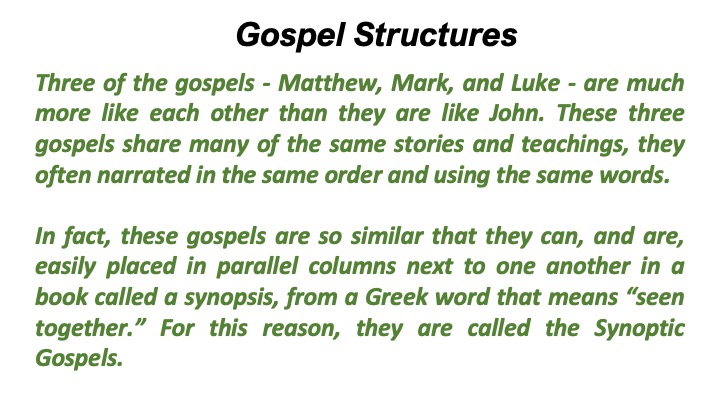
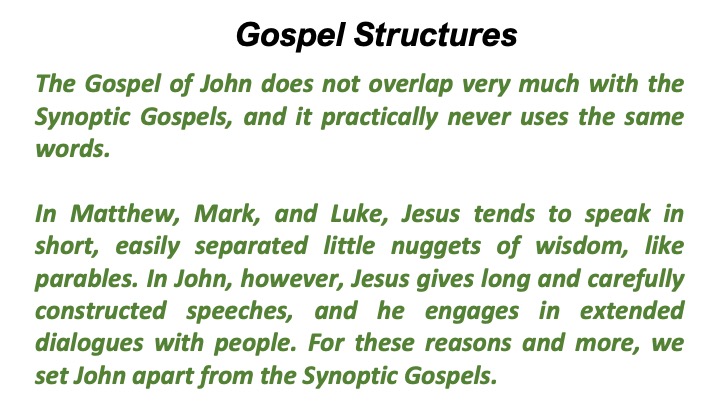
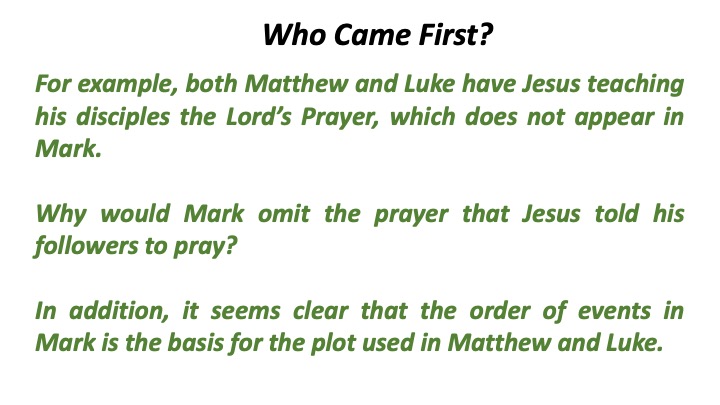
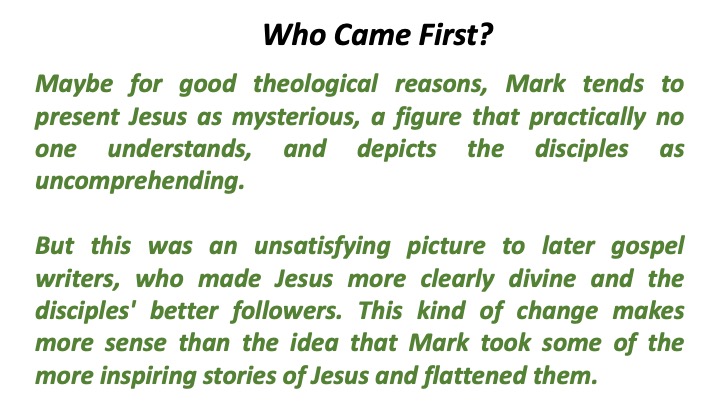
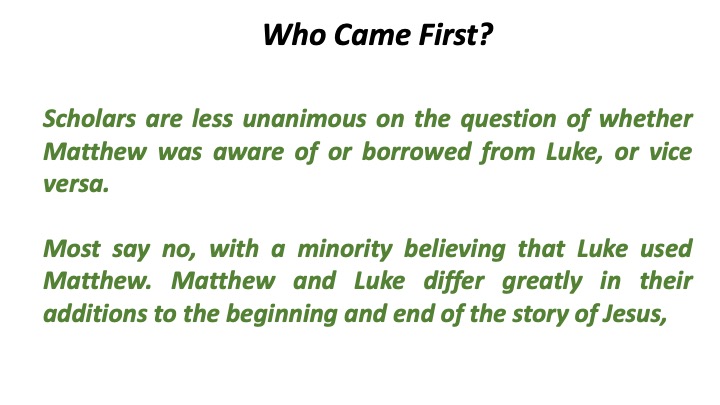
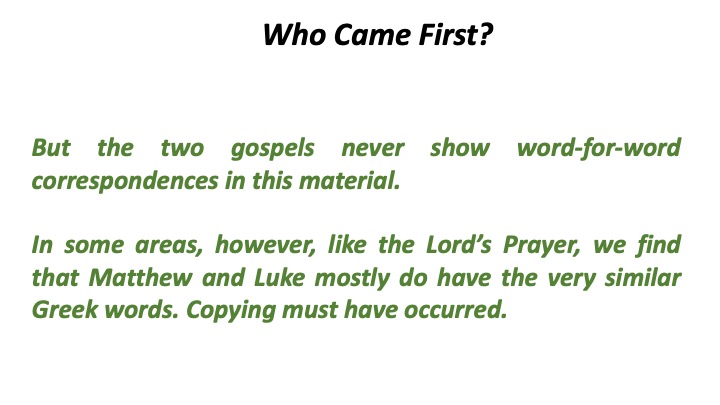
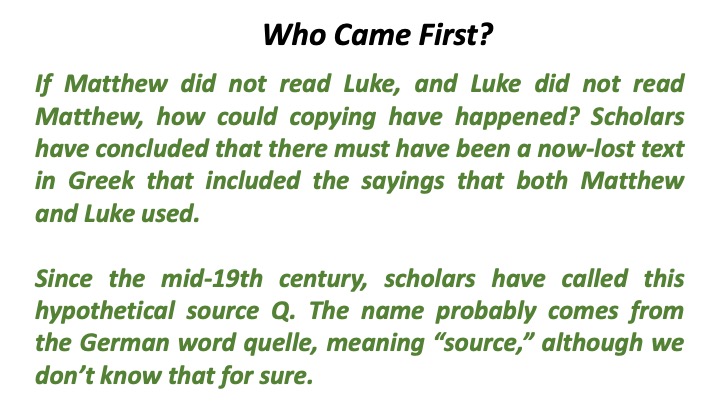
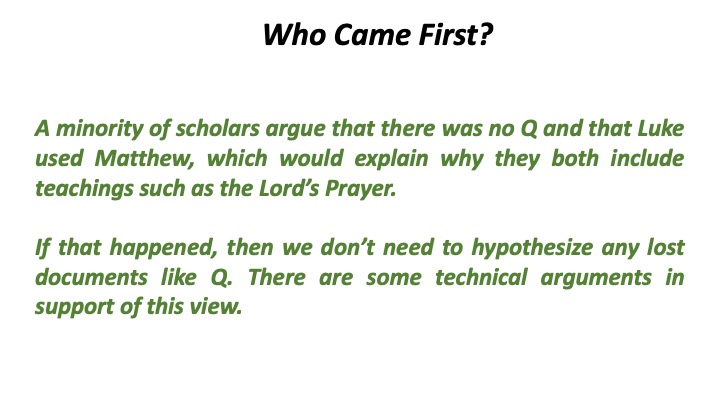
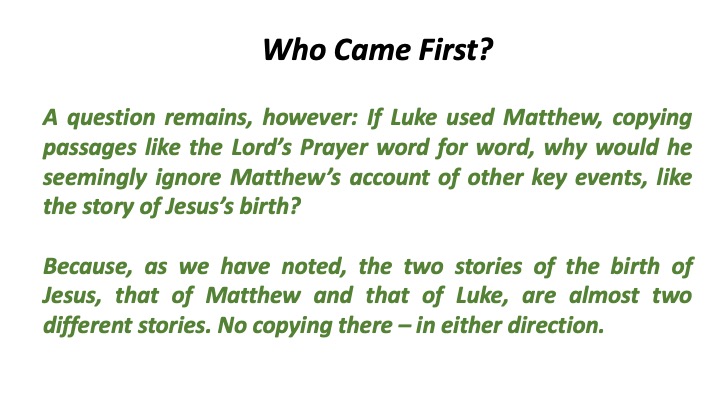
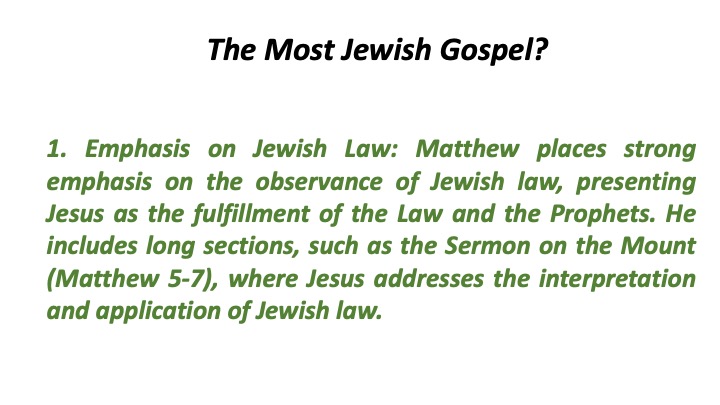
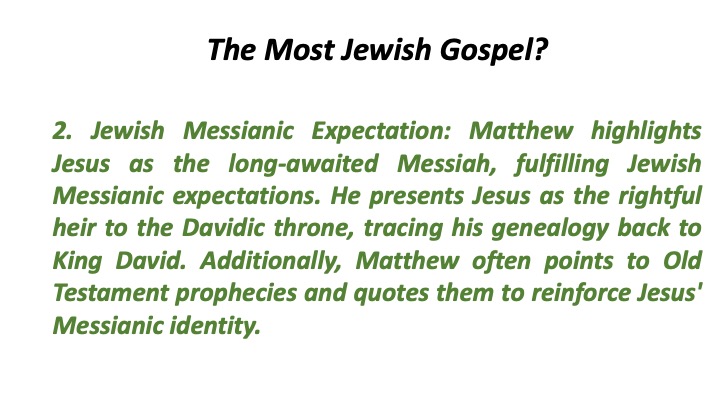
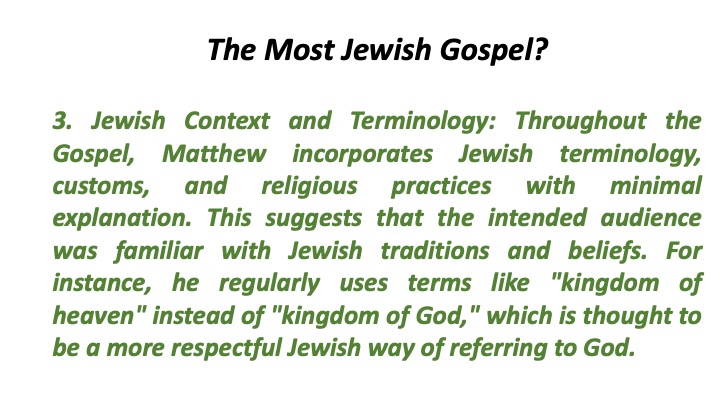
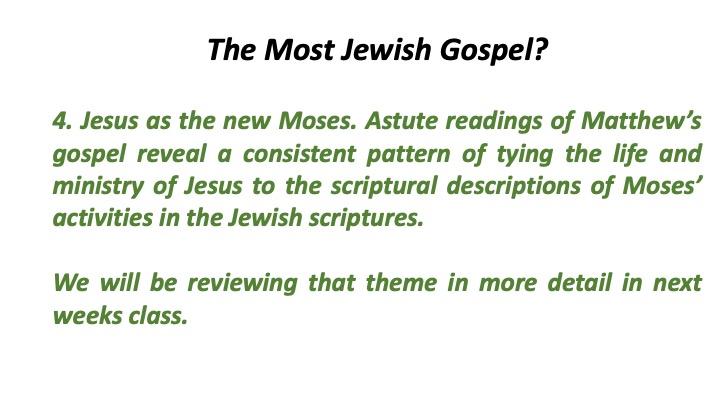
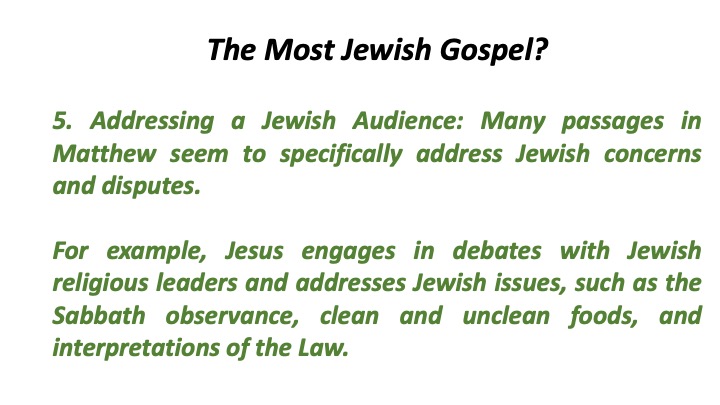
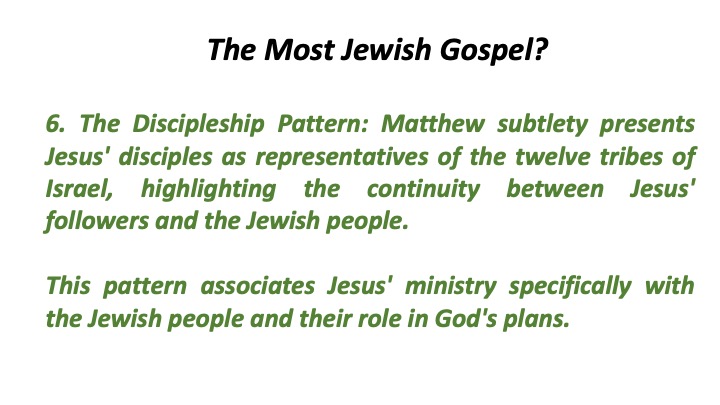
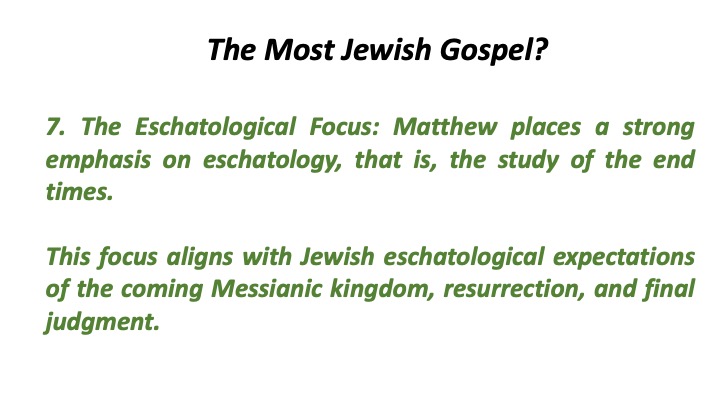
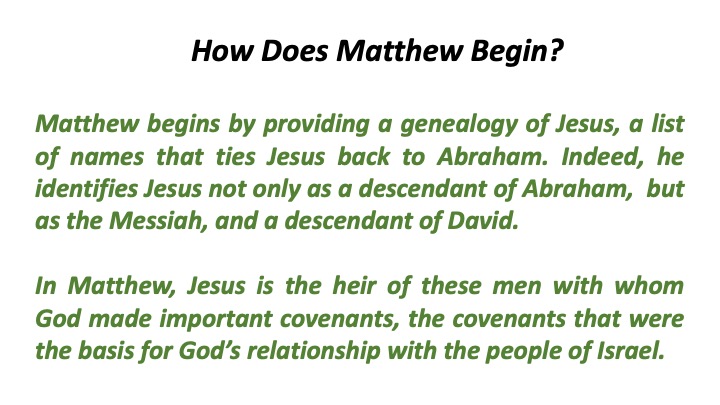
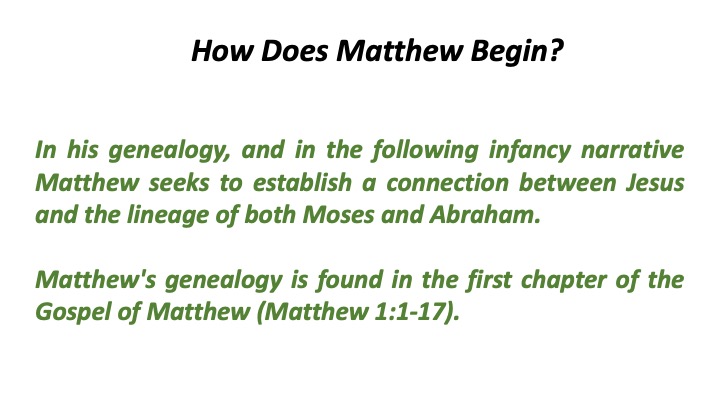
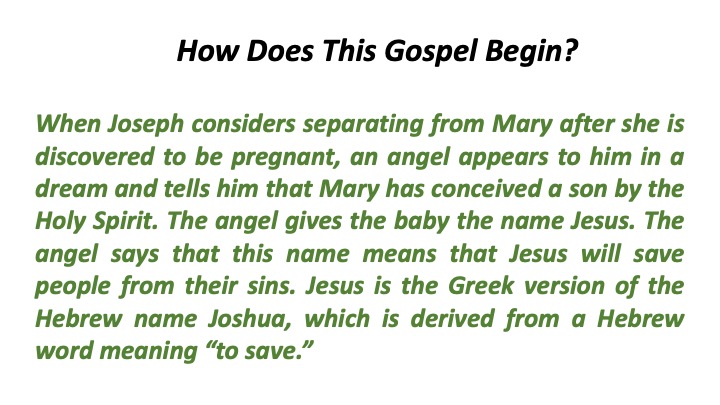
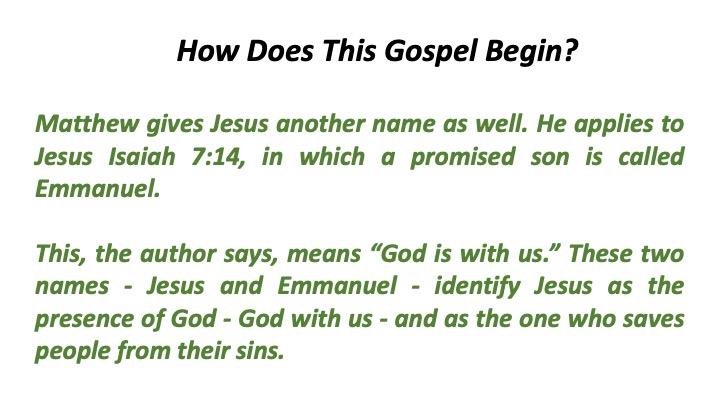
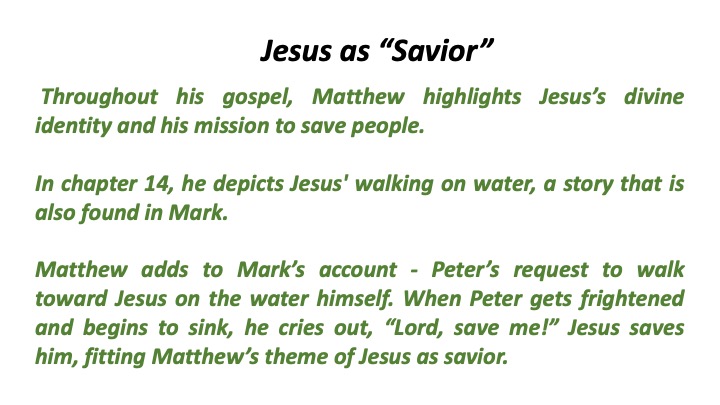
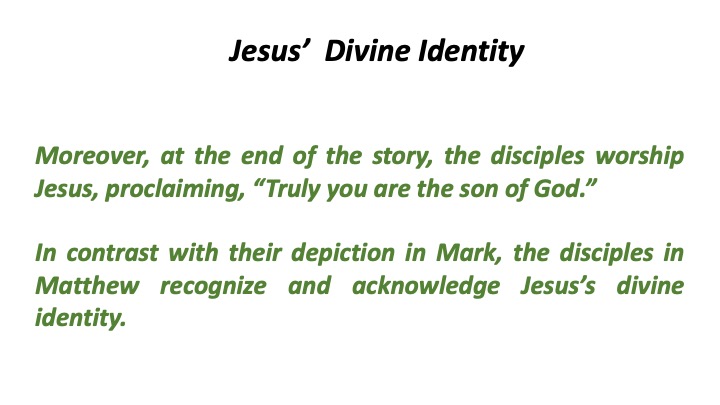
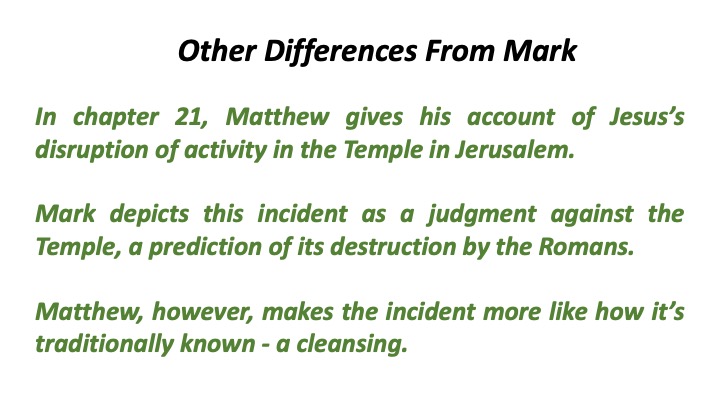
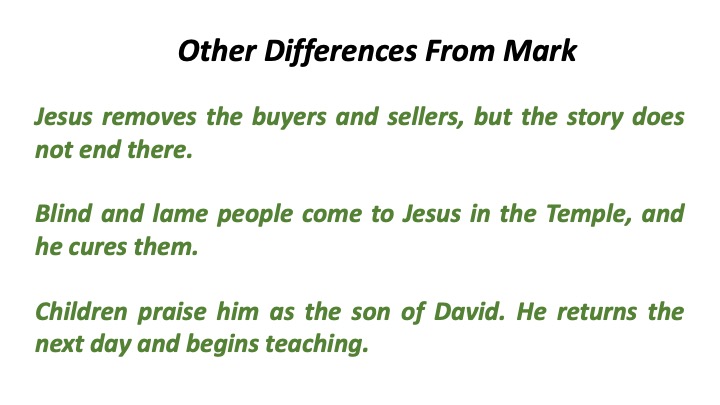
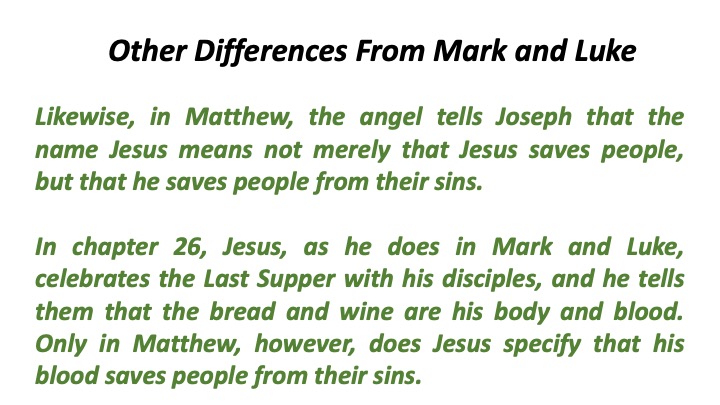
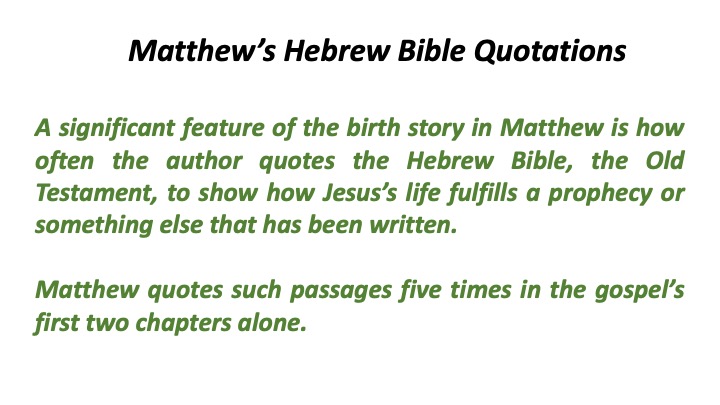
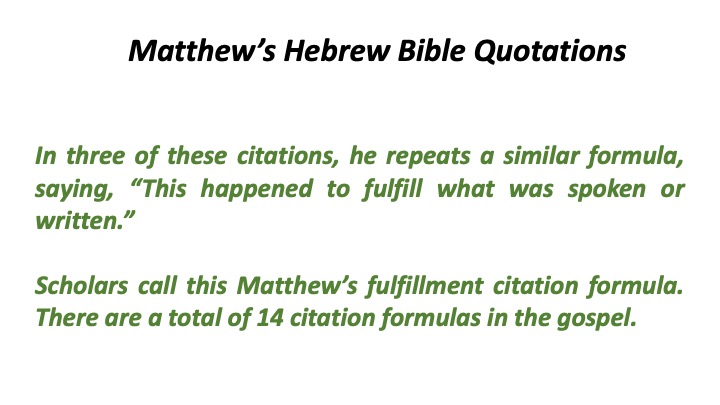
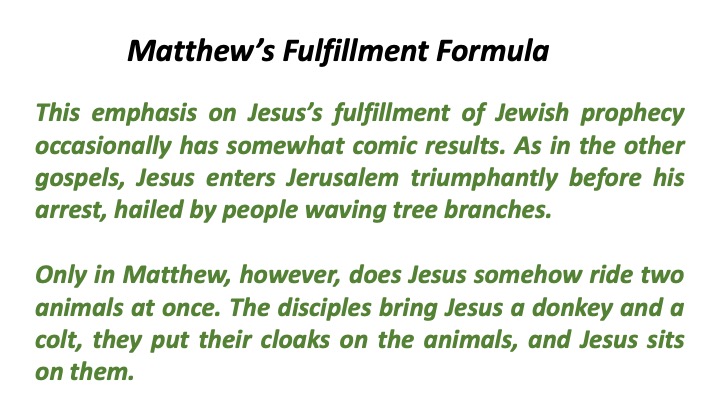
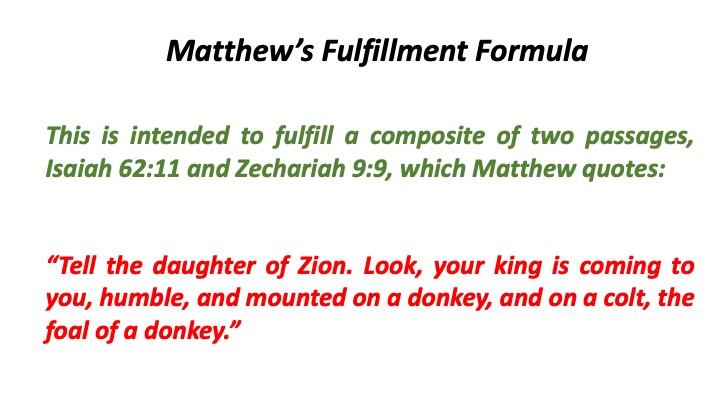
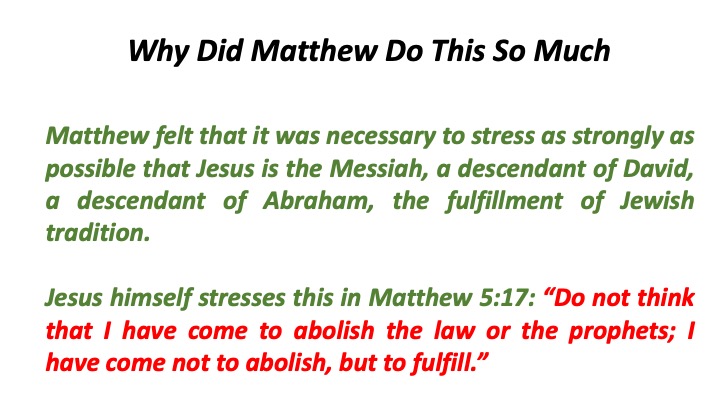
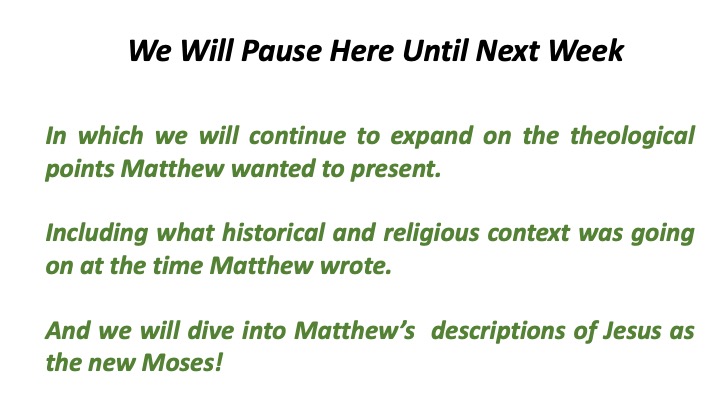
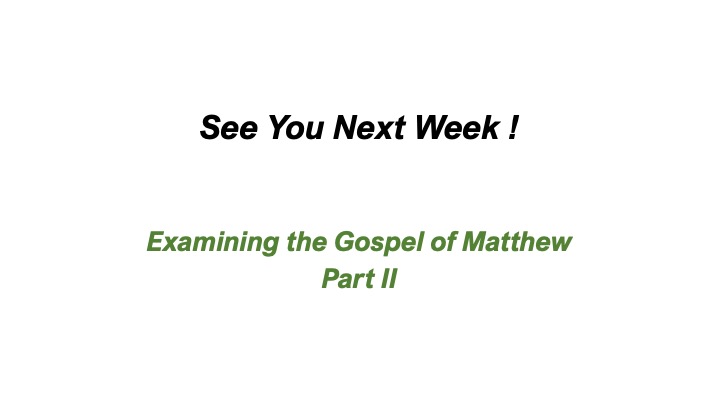
Text of Examining the Gospel of Matthew Week 1
Examining the Gospel of Matthew
What will be our approach?
As we tried to do in Luke-Acts and Mark, we will attempt to examine Matthew as modern scholarship often does.
With an emphasis on engaging the Gospels as literature.
In engaging Mark we began by first noting what was very distinctive in Mark – mainly an almost obsessive plot line regarding the relationship between Jesus and the disciples he chose.
New Testament scholars tend to assume that skilled authors write with a teaching premise that is important to them and build their Gospel around that.
Each gospel writer told the story of Jesus in a way that would communicate the theological message that he believed his community needed to hear. The unknown Christian who wrote what we call the Gospel of Matthew wanted to emphasize the divine nature of Jesus and show how the disciples gradually came to have stronger faith in him. Matthew also presents Jesus as a new Moses who fulfills the biblical law and the messages of the prophets.
In Mark we explored the premise that Mark wanted to show discipleship would be extremely challenging to the first disciples as they were exposed to a very powerful teacher that was exhibiting a reality (possibly divine) that was new to the world.
So, we will begin our analysis of Matthew in a similar vein and explore what Matthew wanted to explore.
And in doing that we need to immediately note how the gospel of Matthew was viewed during most of Christianity’s history.
And that view was that Matthew was probably the first Gospel. Which is why our bibles list the Gospels as “Matthew, Mark, Luke, and John”
And in doing that we need to immediately note how the gospel of Matthew was viewed during most of Christianity’s history.
And that view was that Matthew was probably the first Gospel. Which is why our bibles list the Gospels as “Matthew, Mark, Luke, and John”
In the ancient church of the first few centuries, Matthew was widely believed to be the first of the Gospels.
And since this Gospel seemed to be strongly Jewish in character it seemed to support the notion that it was first, since the Jesus movement was probably predominately Jewish in its beginnings and only became more Gentile later in the first century and increasingly so in the second century.
One of the earliest scholars to consider this issue was Augustine of Hippo, one of Christianity’s greatest theologians, who died in 430. Augustine argued that the Synoptic Gospels were written in the order that they appear in the New Testament: Matthew wrote first, Mark used Matthew to write his gospel, and Luke used both Matthew and Mark. Thanks to Augustine’s great authority in the church, this view prevailed until the modern period.
Today, scholars and historians agree that Mark was the earliest gospel.
Mark is much shorter than Matthew and Luke, and no one has come up with a good explanation for why Mark would have cut out material that appears in the other gospels.
Today, scholars and historians agree that Mark was the earliest gospel.
Mark is much shorter than Matthew and Luke, and no one has come up with a good explanation for why Mark would have cut out material that appears in the other gospels.
But as we will try to show Matthew was Jewish in a rather distinctive and different way than either Mark or Luke.
But the solution of the synoptic problem in the 18th century led to a more modern consensus that Matthew must have had a copy of Mark’s Gospel in front of him as he prepared his Gospel.
Matthew does not explicitly mention the name of its author. Traditionally, it has been attributed to the apostle Matthew, also known as Levi, one of the twelve disciples of Jesus.
Many scholars today question the direct authorship of Matthew, considering it more likely that the gospel was written by an anonymous author who may have drawn upon traditions associated with Matthew.
It is commonly believed that the author of the Gospel of Matthew was a Jewish-Christian, well-versed in Jewish traditions and familiar with the Hebrew Scriptures (Old Testament).
This is evident in the gospel's numerous references to Jewish laws, customs, and prophecies, as well as its emphasis on Jesus as the fulfillment of Jewish messianic expectations.
The Gospel of Matthew's place of composition is uncertain.
Some scholars suggest that it could have been written in Antioch, Syria, or in Galilee, while others propose Alexandria, Egypt.
There is no definite consensus among scholars regarding its specific origin.
What was distinctive about the Gospel as presented by Matthew?
It was very different than Mark, as well as Luke and John. Sometimes we do not realize how different because we have studied all of the Gospels so frequently we often carry around a blend of the Gospels in our minds, without realizing their differences.
Most people, when they think of the Christmas story, think of one biblical narrative that includes the holy family, the midnight hour, a manger, various farm animals, shepherds, angels, wise men and a quiet, little town called Bethlehem.
But many of those elements that people treasure come from Christmas carols. Because the Gospels of Matthew and Luke deal with story in two very different ways.
The gospel authors were less like newspaper reporters and more like preachers, getting their followers to believe in and follow Jesus as best they could in their unique circumstances.
Despite that, the gospel narratives are often similar to one another.
From this, many historians have opined that the author of Matthew used Mark, copying much of it while changing some parts and making his own additions.
All four of the gospels in the New Testament share the same basic structure. Each is mostly or entirely devoted to the ministry of Jesus in the final years of his life, roughly from when he was baptized by John the Baptist to when he was crucified and rose again.
Each devotes a disproportionate amount of space to Jesus’s last days, his arrest, crucifixion, and resurrection in Jerusalem.
And they contain a fair number of similar stories: not only Jesus being baptized by John, but also Jesus feeding large numbers of people, healing people, teaching his disciples and the crowds, and coming into conflict with Jewish leaders.
But as you are aware, and we will see, they all have unique interpretations of these events.
Three of the gospels - Matthew, Mark, and Luke - are much more like each other than they are like John. These three gospels share many of the same stories and teachings, they often narrated in the same order and using the same words.
In fact, these gospels are so similar that they can, and are, easily placed in parallel columns next to one another in a book called a synopsis, from a Greek word that means “seen together.” For this reason, they are called the Synoptic Gospels.
The Gospel of John does not overlap very much with the Synoptic Gospels, and it practically never uses the same words.
In Matthew, Mark, and Luke, Jesus tends to speak in short, easily separated little nuggets of wisdom, like parables. In John, however, Jesus gives long and carefully constructed speeches, and he engages in extended dialogues with people. For these reasons and more, we set John apart from the Synoptic Gospels.
For example, both Matthew and Luke have Jesus teaching his disciples the Lord’s Prayer, which does not appear in Mark.
Why would Mark omit the prayer that Jesus told his followers to pray?
In addition, it seems clear that the order of events in Mark is the basis for the plot used in Matthew and Luke.
Maybe for good theological reasons, Mark tends to present Jesus as mysterious, a figure that practically no one understands, and depicts the disciples as uncomprehending.
But this was an unsatisfying picture to later gospel writers, who made Jesus more clearly divine and the disciples' better followers. This kind of change makes more sense than the idea that Mark took some of the more inspiring stories of Jesus and flattened them.
Scholars are less unanimous on the question of whether Matthew was aware of or borrowed from Luke, or vice versa.
Most say no, with a minority believing that Luke used Matthew. Matthew and Luke differ greatly in their additions to the beginning and end of the story of Jesus,
But the two gospels never show word-for-word correspondences in this material.
In some areas, however, like the Lord’s Prayer, we find that Matthew and Luke mostly do have the very similar Greek words. Copying must have occurred.
If Matthew did not read Luke, and Luke did not read Matthew, how could copying have happened? Scholars have concluded that there must have been a now-lost text in Greek that included the sayings that both Matthew and Luke used.
Since the mid-19th century, scholars have called this hypothetical source Q. The name probably comes from the German word quelle, meaning “source,” although we don’t know that for sure.
A minority of scholars argue that there was no Q and that Luke used Matthew, which would explain why they both include teachings such as the Lord’s Prayer.
If that happened, then we don’t need to hypothesize any lost documents like Q. There are some technical arguments in support of this view.
A question remains, however: If Luke used Matthew, copying passages like the Lord’s Prayer word for word, why would he seemingly ignore Matthew’s account of other key events, like the story of Jesus’s birth?
Because, as we have noted, the two stories of the birth of Jesus, that of Matthew and that of Luke, are almost two different stories. No copying there – in either direction.
The Most Jewish Gospel?
1. Emphasis on Jewish Law: Matthew places strong emphasis on the observance of Jewish law, presenting Jesus as the fulfillment of the Law and the Prophets. He includes long sections, such as the Sermon on the Mount (Matthew 5-7), where Jesus addresses the interpretation and application of Jewish law.
2. Jewish Messianic Expectation: Matthew highlights Jesus as the long-awaited Messiah, fulfilling Jewish Messianic expectations. He presents Jesus as the rightful heir to the Davidic throne, tracing his genealogy back to King David. Additionally, Matthew often points to Old Testament prophecies and quotes them to reinforce Jesus' Messianic identity.
3. Jewish Context and Terminology: Throughout the Gospel, Matthew incorporates Jewish terminology, customs, and religious practices with minimal explanation. This suggests that the intended audience was familiar with Jewish traditions and beliefs. For instance, he regularly uses terms like "kingdom of heaven" instead of "kingdom of God," which is thought to be a more respectful Jewish way of referring to God.
4. Jesus as the new Moses. Astute readings of Matthew’s gospel reveal a consistent pattern of tying the life and ministry of Jesus to the scriptural descriptions of Moses’ activities in the Jewish scriptures.
We will be reviewing that theme in more detail in next weeks class.
5. Addressing a Jewish Audience: Many passages in Matthew seem to specifically address Jewish concerns and disputes.
For example, Jesus engages in debates with Jewish religious leaders and addresses Jewish issues, such as the Sabbath observance, clean and unclean foods, and interpretations of the Law.
5. Addressing a Jewish Audience: Many passages in Matthew seem to specifically address Jewish concerns and disputes.
For example, Jesus engages in debates with Jewish religious leaders and addresses Jewish issues, such as the Sabbath observance, clean and unclean foods, and interpretations of the Law.
7. The Eschatological Focus: Matthew places a strong emphasis on eschatology, that is, the study of the end times.
This focus aligns with Jewish eschatological expectations of the coming Messianic kingdom, resurrection, and final judgment.
Matthew begins by providing a genealogy of Jesus, a list of names that ties Jesus back to Abraham. Indeed, he identifies Jesus not only as a descendant of Abraham, but as the Messiah, and a descendant of David.
In Matthew, Jesus is the heir of these men with whom God made important covenants, the covenants that were the basis for God’s relationship with the people of Israel.
In his genealogy, and in the following infancy narrative Matthew seeks to establish a connection between Jesus and the lineage of both Moses and Abraham.
Matthew's genealogy is found in the first chapter of the Gospel of Matthew (Matthew 1:1-17).
When Joseph considers separating from Mary after she is discovered to be pregnant, an angel appears to him in a dream and tells him that Mary has conceived a son by the Holy Spirit. The angel gives the baby the name Jesus. The angel says that this name means that Jesus will save people from their sins. Jesus is the Greek version of the Hebrew name Joshua, which is derived from a Hebrew word meaning “to save.”
Matthew gives Jesus another name as well. He applies to Jesus Isaiah 7:14, in which a promised son is called Emmanuel.
This, the author says, means “God is with us.” These two names - Jesus and Emmanuel - identify Jesus as the presence of God - God with us - and as the one who saves people from their sins.
Throughout his gospel, Matthew highlights Jesus’s divine identity and his mission to save people.
In chapter 14, he depicts Jesus' walking on water, a story that is also found in Mark.
Matthew adds to Mark’s account - Peter’s request to walk toward Jesus on the water himself. When Peter gets frightened and begins to sink, he cries out, “Lord, save me!” Jesus saves him, fitting Matthew’s theme of Jesus as savior.
Moreover, at the end of the story, the disciples worship Jesus, proclaiming, “Truly you are the son of God.”
In contrast with their depiction in Mark, the disciples in Matthew recognize and acknowledge Jesus’s divine identity.
In chapter 21, Matthew gives his account of Jesus’s disruption of activity in the Temple in Jerusalem.
Mark depicts this incident as a judgment against the Temple, a prediction of its destruction by the Romans.
Matthew, however, makes the incident more like how it’s traditionally known - a cleansing.
Jesus removes the buyers and sellers, but the story does not end there.
Blind and lame people come to Jesus in the Temple, and he cures them.
Children praise him as the son of David. He returns the next day and begins teaching.
Likewise, in Matthew, the angel tells Joseph that the name Jesus means not merely that Jesus saves people, but that he saves people from their sins.
In chapter 26, Jesus, as he does in Mark and Luke, celebrates the Last Supper with his disciples, and he tells them that the bread and wine are his body and blood. Only in Matthew, however, does Jesus specify that his blood saves people from their sins.
A significant feature of the birth story in Matthew is how often the author quotes the Hebrew Bible, the Old Testament, to show how Jesus’s life fulfills a prophecy or something else that has been written.
Matthew quotes such passages five times in the gospel’s first two chapters alone.
In three of these citations, he repeats a similar formula, saying, “This happened to fulfill what was spoken or written.”
Scholars call this Matthew’s fulfillment citation formula. There are a total of 14 citation formulas in the gospel.
This emphasis on Jesus’s fulfillment of Jewish prophecy occasionally has somewhat comic results. As in the other gospels, Jesus enters Jerusalem triumphantly before his arrest, hailed by people waving tree branches.
Only in Matthew, however, does Jesus somehow ride two animals at once. The disciples bring Jesus a donkey and a colt, they put their cloaks on the animals, and Jesus sits on them.
This is intended to fulfill a composite of two passages, Isaiah 62:11 and Zechariah 9:9, which Matthew quotes:
“Tell the daughter of Zion. Look, your king is coming to you, humble, and mounted on a donkey, and on a colt, the foal of a donkey.”
Matthew felt that it was necessary to stress as strongly as possible that Jesus is the Messiah, a descendant of David, a descendant of Abraham, the fulfillment of Jewish tradition.
Jesus himself stresses this in Matthew 5:17: “Do not think that I have come to abolish the law or the prophets; I have come not to abolish, but to fulfill.”
In which we will continue to expand on the theological points Matthew wanted to present.
Including what historical and religious context was going on at the time Matthew wrote.
And we will dive into Matthew’s descriptions of Jesus as the new Moses!
See You Next Week !
Examining the Gospel of Matthew
Part II